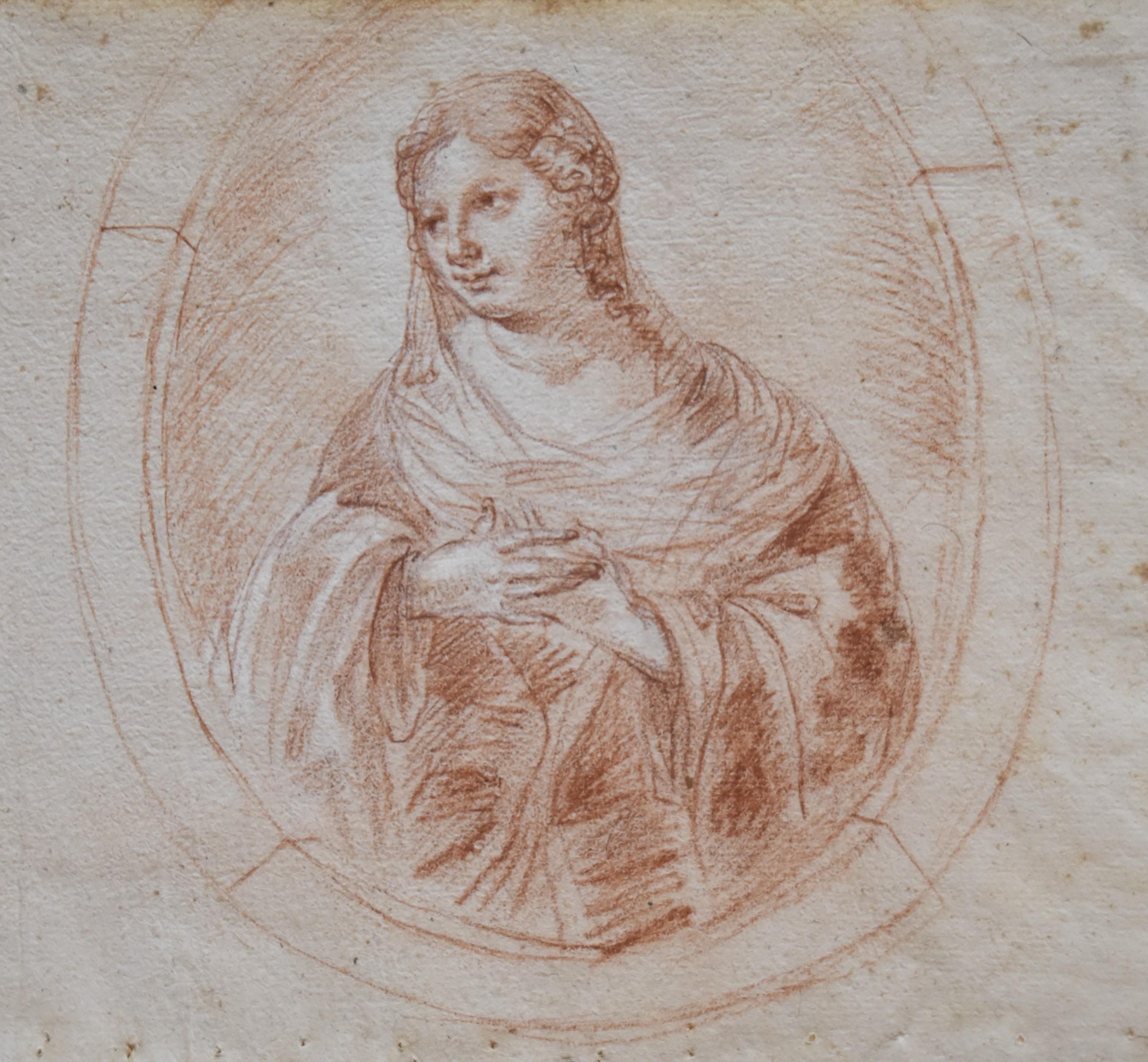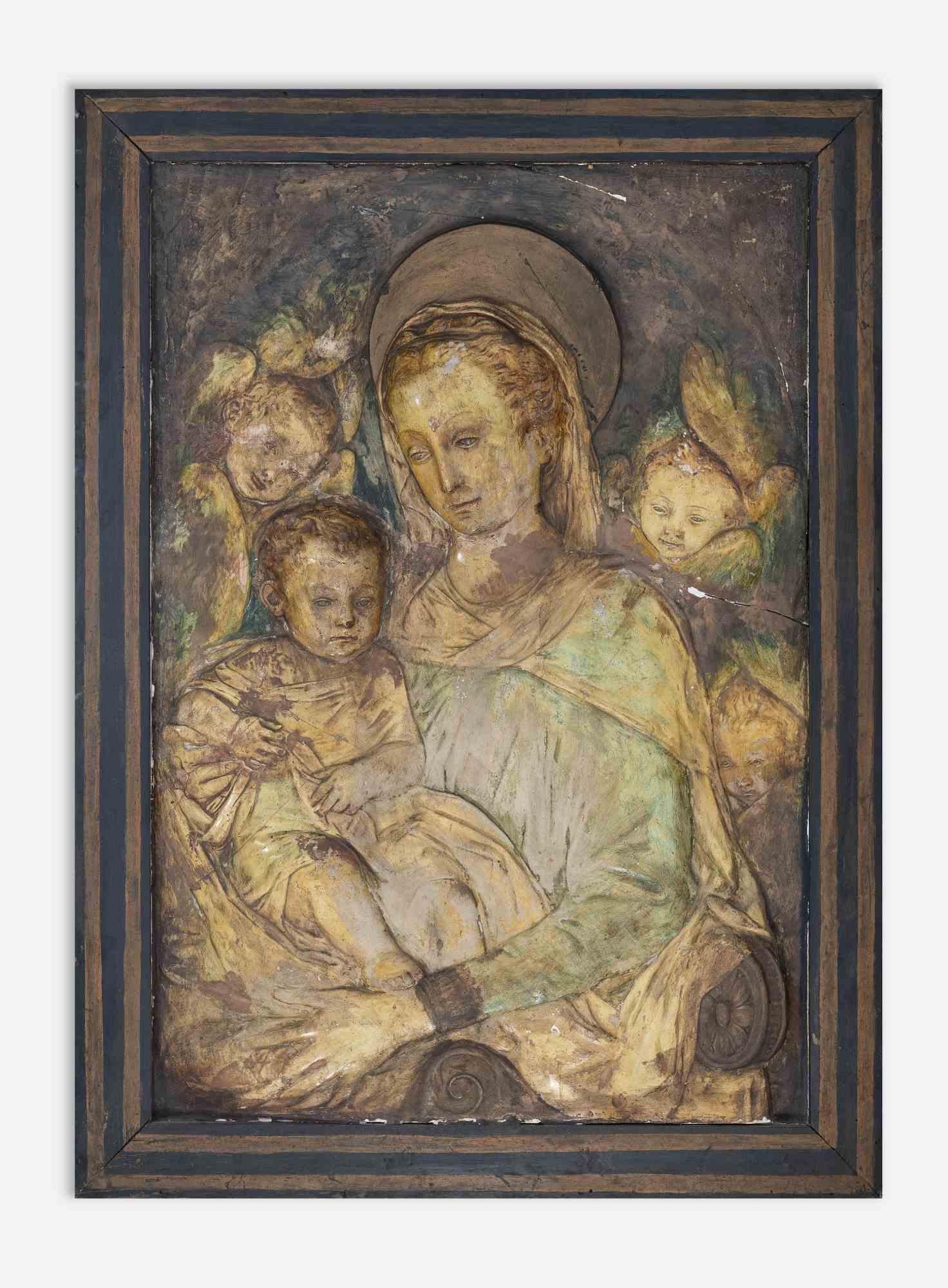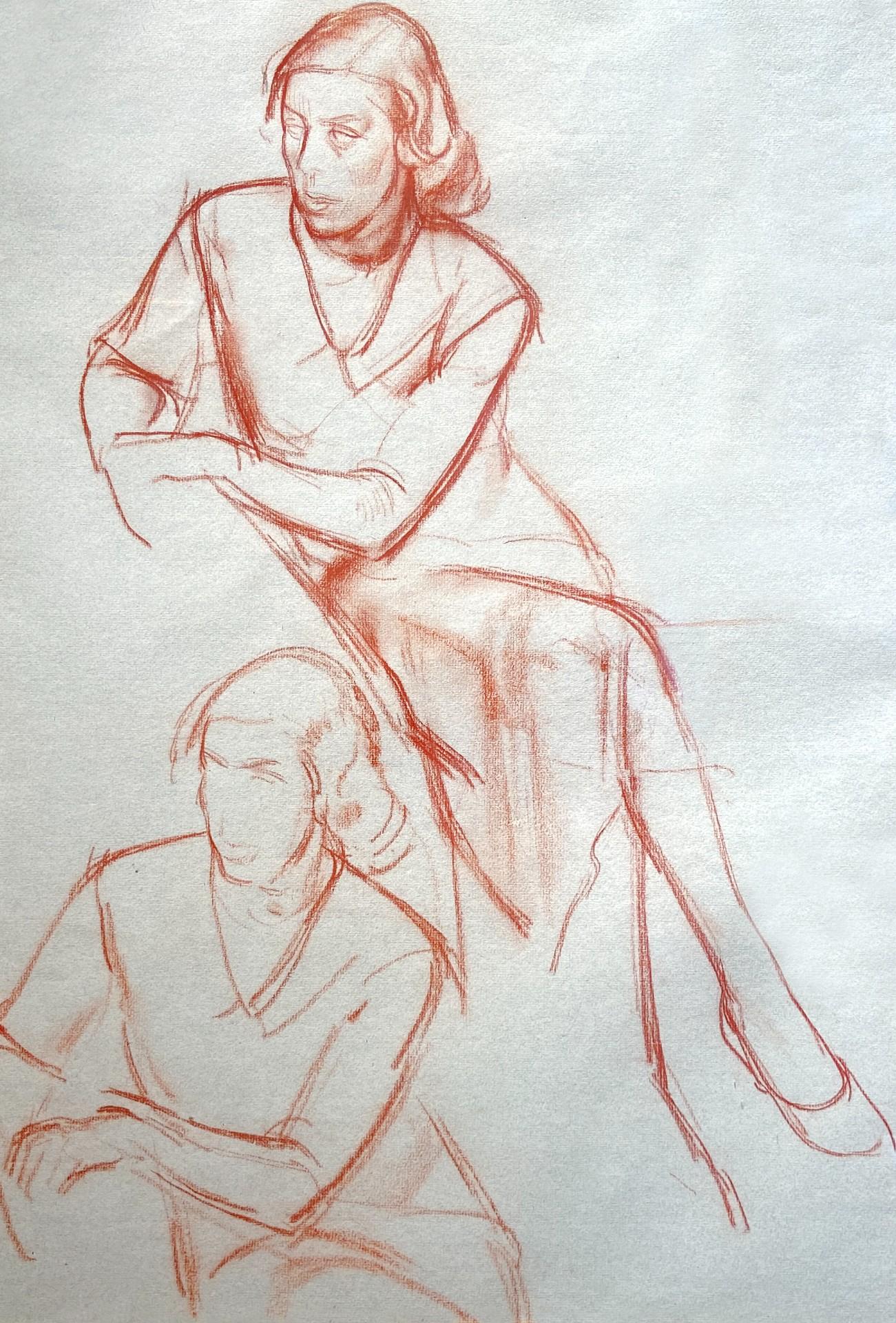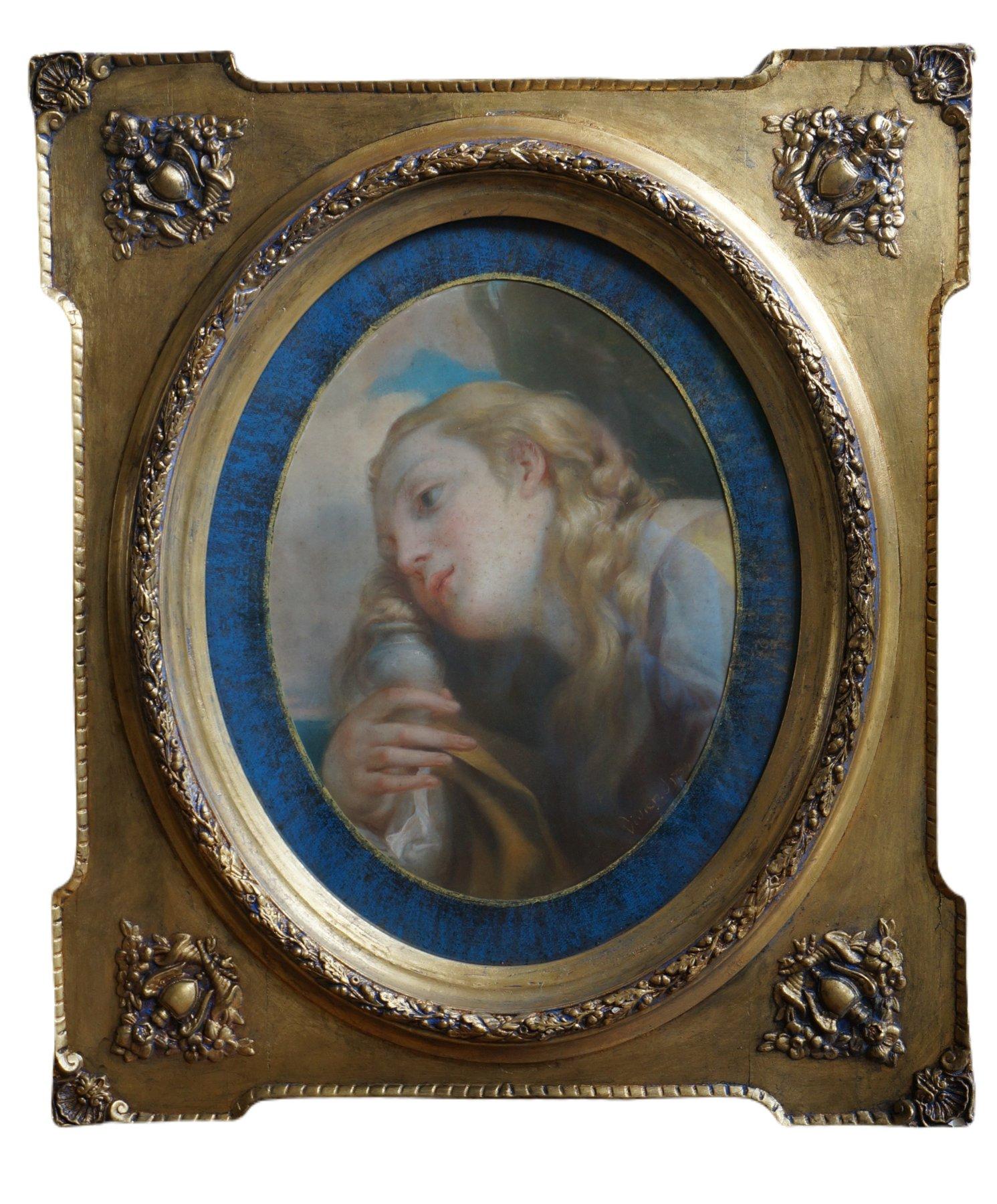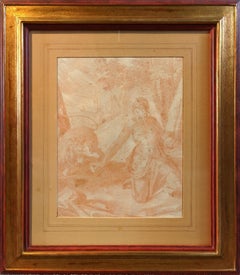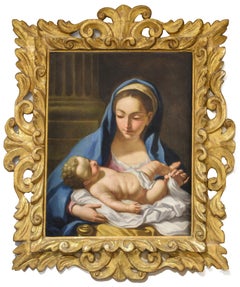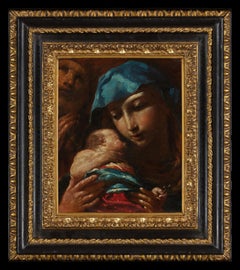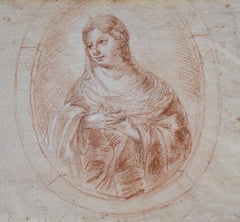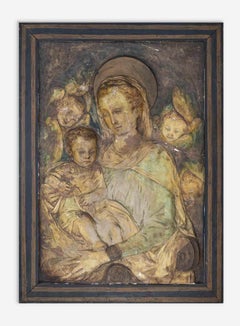Items Similar to Reading Madonna drawing. Red chalk on paper.
Want more images or videos?
Request additional images or videos from the seller
1 of 8
Francesco FernandiReading Madonna drawing. Red chalk on paper.
$4,340
$6,20030% Off
£3,264.72
£4,663.8930% Off
€3,782.03
€5,402.9030% Off
CA$6,118.50
CA$8,740.7230% Off
A$6,804.18
A$9,720.2630% Off
CHF 3,571.29
CHF 5,101.8430% Off
MX$82,973.73
MX$118,533.8930% Off
NOK 45,133.97
NOK 64,477.1030% Off
SEK 42,314.90
SEK 60,449.8530% Off
DKK 28,228.60
DKK 40,326.5730% Off
About the Item
Inscribed: front, brown ink, bottom left, F. Imperiali pinx…; bottom right, R. Rol..(?). Back, brown ink, top left, Roma, Gune(?) 1742 / F. Impeririali ping…;[illegible] R. deline..(?).
The Virgin Mary has been the subject of various representations throughout the history of Western art. She was an important character in outstanding scenes of sacred history, from the Annunciation of the birth of her son Jesus to different moments of her passion and death. Later she appears together with the apostles in the coming of the Holy Spirit and is the protagonist of apparitions and miraculous events that Catholics represented in cloisters and churches, showing the importance that her figure had in the religious development and practice of Christians. Starting in the 17th century, with the renewal of the imagery that the counter-reformation undertook, her figure will continue to be outstanding, many times in representations that show her alone and pensive, possibly meditating on the role that she had to fulfil, as mentioned by the evangelist Luke (2:16-21); calm, reading a book of hours, alone and isolated, generated a devotional image of frequent representation. It is in this way that it appears in our work, concentrated, in its prayer book.
Attributed to Francesco Fernandi, L'Imperiali, based on the inscriptions on the recto and verso, the work copies a painting that was attributed to Carlo Maratta (1625 - 1713) of which we know at least one version that has been considered by a follower (National Trust Collection, inv. 872096, oil on canvas, 43.2 x 34.3 cm).
Due to its realization, our drawing confronts us with the work of a skilled artist who knows the medium he uses, with whom he achieves an image of remarkable delicacy that immediately refers to Maratta's creations. Trained in Milan with Carlo Vimercati, after his arrival in Rome around 1705, he was protected by Cardinal Giuseppe Renato Imperiali whose name he will add to his. He came into contact with Carlo Maratta's workshop and participated in various projects together with disciples and followers.
All of our works are covered by our own guarantee of authenticity which covers the work for its lifetime of ownership with the purchaser. We carry out stringent due diligence on every work listed, should we make an error then we offer a full money back guarantee on any purchase.
- Creator:Francesco Fernandi (1679 - 1740)
- Dimensions:Height: 15.36 in (39 cm)Width: 12.21 in (31 cm)
- Medium:
- Period:
- Condition:
- Gallery Location:New York, NY
- Reference Number:1stDibs: LU1599211837262
About the Seller
5.0
Vetted Professional Seller
Every seller passes strict standards for authenticity and reliability
Established in 2007
1stDibs seller since 2021
44 sales on 1stDibs
Typical response time: 1 hour
- ShippingRetrieving quote...Shipping from: New York, NY
- Return Policy
Authenticity Guarantee
In the unlikely event there’s an issue with an item’s authenticity, contact us within 1 year for a full refund. DetailsMoney-Back Guarantee
If your item is not as described, is damaged in transit, or does not arrive, contact us within 7 days for a full refund. Details24-Hour Cancellation
You have a 24-hour grace period in which to reconsider your purchase, with no questions asked.Vetted Professional Sellers
Our world-class sellers must adhere to strict standards for service and quality, maintaining the integrity of our listings.Price-Match Guarantee
If you find that a seller listed the same item for a lower price elsewhere, we’ll match it.Trusted Global Delivery
Our best-in-class carrier network provides specialized shipping options worldwide, including custom delivery.More From This Seller
View AllSaint Jerome in the Desert, Prague school sanguine drawing
Located in New York, NY
Saint Jerome in the Desert Prague school sanguine drawing.
Category
Early 17th Century Old Masters Figurative Drawings and Watercolors
Materials
Chalk, Paper
$3,200 Sale Price
54% Off
Free Shipping
Italian Madonna and Child 18th Century
Located in New York, NY
Good condition overall. With beautiful carved wooden frame.
All of our works are covered by our own guarantee of authenticity which covers the work for its lifetime of ownership wit...
Category
18th Century Rococo Figurative Paintings
Materials
Oil, Canvas
Holy Family, by the bolgonese master.
By Giuseppe Maria Crespi, Lo Spagnuolo
Located in New York, NY
This exquisite painting, resembling a precious jewel, serves as an exceptional illustration of the devotional cabinet paintings created by Giuseppe Maria Crespi, a highly original Bolognese artist during the late 17th and early 18th centuries. Crespi's distinctiveness extended beyond his unique style and technique to the subjects he chose to portray. While his portraits and genre paintings often displayed a light-hearted and even irreverent tone, his treatment of religious themes resonated with deep emotion, even in its most inventive forms.
This recently uncovered work by Crespi is a typical representation, invoking the tender
connection between mother and child, and the Child's destiny, all within a compact and intimate format. Executed on a small scale, the painting showcases Crespi's remarkable sensitivity and mastery of paint, especially evident in the expressive brushwork of the drapery.
The restrained and focused composition of the Holy Family allows for contemplation of the figures. Mary cradles the Christ child gently, seemingly presenting him to the viewer, her gaze
knowing as the infant holds a diminutive cross, symbolizing his future crucifixion. Joseph appears in the background, emerging from the left side of the frame, gazing upward with folded hands in prayer.
Individual motifs from this painting reappear in other works by Crespi, suggesting a synthesis of familiar elements into a vibrant composition. The artist's revisitation of designs throughout his career is evident, and this painting on copper likely belongs to a later period, reflecting stylistic ties to other works and Crespi's increased production of smaller devotional pieces.
Distinguished by its cool palette, bold coloration, and the expressive force of the artist's hand, this Holy Family painting...
Category
Early 1700s Baroque Figurative Paintings
Materials
Copper
$30,400 Sale Price
27% Off
Free Shipping
Sanguine drawing "Shepherdess on a Donkey" by Nicolaes Berchem
By Nicolaes Berchem
Located in New York, NY
Provenance: Mercedes von Dietrichtein, Buenos Aires. Alexander von Dietrichstein. By descendants Morritz von Diestrichstein.
Nicolaes Pieterszoon Berchem (1 October 1620 – 18 February 1683) was a highly esteemed and prolific Dutch Golden Age painter of pastoral landscapes, populated with mythological or biblical figures, but also of a number of allegories and genre pieces.
He was a member of the second generation of "Dutch Italianate landscape" painters. These were artists who travelled to Italy, or aspired to, in order to soak up the romanticism of the country, bringing home sketchbooks full of drawings of classical ruins and pastoral imagery. His paintings, of which he produced an immense number, (Hofstede de Groot claimed around 850, although many are misattributed), were in great demand, as were his 80 etchings and 500 drawings. His landscapes, painted in the Italian style of idealized rural scenes, with hills, mountains, cliffs and trees in a golden dawn...
Category
17th Century Dutch School Figurative Drawings and Watercolors
Materials
Paper, Chalk
$4,000 Sale Price
68% Off
Free Shipping
Peasant Family, Cornelis Bega. Dutch Golden age painter and engraver.
By Cornelis Bega
Located in New York, NY
Documents indicate that Cornelis Pietersz Bega was born in either 1631 or 1632 in Haarlem. His grandfather was the renowned history painter Cornelis Cornelisz van Haarlem (Dutch, 1562 - 1638), and his extended family included many other more minor painters, sculptors, and craftsmen. In the spring of 1653 he traveled with the portraitist and still life painter Vincent Laurensz van der Vinne (1628–1702) through Germany, visiting Frankfurt am Main, Heidelberg, Strasbourg, and Basel. Although, like Van der Vinne, he may have intended to continue on to Rome, Bega instead returned to Haarlem in June of that year. He joined the Guild of Saint Luke in 1654. Bega died unmarried in 1664 at the young age of 32, likely a victim of the plague that claimed many lives in Haarlem that year.
Dutch artist biographer Arnold Houbraken wrote that Bega was the “first and best pupil” of Adriaen van Ostade (Dutch, 1610 - 1685), a painter of low-life genre scenes. Bega similarly specialized in paintings of jovial taverngoers, smokers, quack doctors, alchemists, and musicians, but he also created tender and sympathetic images of peasant families and nursing mothers. Like Ostade, he also produced etchings, and he may have been one of the first Dutch artists to experiment with monotypes. Bega was also a confident draughtsman, and made numerous chalk drawings remarkable for their sculptural quality. Houbraken wrote that Bega and his close friend Leendert van der Cooghen (1632–1681) frequently drew from life together.
Early in his career, Bega painted in a loose, rough style similar to Ostade, although his paintings differ from Ostade’s in that they exhibit a greater degree of monumentality and occasionally include classical elements and figures derived from live models. Bega may have been influenced by the classicizing tradition in Haarlem painting, which he would have known both from the extensive art collection he inherited from his grandfather, as well as from contemporary Haarlem painters who had trained there, such as Salomon (1597–1664) and Jan de Bray...
Category
17th Century Dutch School Interior Paintings
Materials
Pastel, Chalk, Satin Paper
18th Century Italian oil on copper, Raphael School
By (after) Raphael (Raffaello Sanzio da Urbino)
Located in New York, NY
18th Century Italian oil on copper portrait in the style of Raphael. Excellent condition.
Category
18th Century Figurative Paintings
Materials
Copper
You May Also Like
Signed Antoniucci Volti Red Chalk Portrait, Double Sided
By Antoniucci Volti
Located in New York, NY
Antoniucci Volti (French, 1915-1989)
Untitled (Double Sided Portrait), 1969
Red chalk on paper
14 3/4 x 11 in.
Each side signed: Volti
Sculptor, painter, and printmaker Antoniucci Volti was born in Albano, Italy, in 1915. His family lived in there until 1920 when the family moved to France to stay. Volti studied at the Ecole des Arts Decoratifs in Nice from 1928 to 1920. By 1932 the young artist had won a gold medal for two polychrome bas-reliefs before going to Paris, where he entered the studio of Jean Boucher at the Ecole Nationale des Beaux-Arts in Paris at the age of only fifteen.
After serving in the Second World War, when he was interned as a prisoner of war in Bavaria, he returned in poor health to Paris, only to find his studio destroyed. From 1947 he showed work at various Paris Salons and, in 1954 and 1955 at the Brussels and Antwerp Biennales. In 1957 a retrospective of his work was organized at the Museum Rodin in Paris. He died in Paris in 1989
Works by Volti are in leading museums such as the Musee National d'Art Modern...
Category
1960s Modern Portrait Drawings and Watercolors
Materials
Paper, Chalk
18th Century, Portrait of a Lady in a Tondo, red chalk drawing
Located in Paris, FR
French (?) school circa 1770
Portrait of a Lady in a Tondo,
red chalk on paper
20 x 29 cm
Numbered 25 on the upper left
Little holes in the bottom (intended for binding)
Not framed
...
Category
1770s Baroque Portrait Drawings and Watercolors
Materials
Chalk
Old Masters Chalk Drawing, 17th Century Italian Sanguine on Paper
Located in London, GB
Sanguine chalk on paper
Image size: 7 x 8 1/2 inches (18 x 22 cm)
Acid free cut-out mount
This 17th century drawing depicts a reclining woman with her back.
The Sanguine chalk that...
Category
17th Century Italian School Figurative Drawings and Watercolors
Materials
Paper, Chalk
Madonna and Child - Colored Chalk Drawing - 19th Century
Located in Roma, IT
Madonna and Child is a beautiful colored chalk low relief realized in the 19th Century by Anonymous Artist.
Frame included: 96x70 cm.
Good condition except some minor cracks and lo...
Category
19th Century Modern Figurative Drawings and Watercolors
Materials
Paper, Chalk
$1,611 Sale Price
25% Off
Studies of a Woman Sitting, Red Chalk Drawing, Modern British Artist, Framed
By James Stroudley
Located in London, GB
Red chalk on paper
Image size: 21 x 14 1/2 inches (54 x 37 cm)
Gilt frame
James Stroudley
Stroudley was born in London on 17 June 1906, the son of James Stroudley, showcard and ticket writer. He studied at Clapham School of Art (1923-27) and then at the Royal College of Art (1927-30), where his teachers included Alan Gwynne-Jones and William Rothenstein. As a recipient of the first Abbey Scholarship he was able to spend three years in Italy from 1930, where he absorbed the influences of Giotto and Piero della Francesca, and produced one of the last wholly satisfying decorative cycles by a Rome Scholar of the period. From 1934, he exhibited at the Royal Society of British Artists, and was elected to its membership in the following year.
From the Second World War – in which he worked with the Camouflage Unit – Stroudley taught at St Martin’s School of Art and was a visiting lecturer at the Royal Academy Schools. Though he continued to live in London, his later work, exhibited at the Royal Academy from 1955, indicated regular painting trips to Kent and Sussex coasts. However, much of his later work was abstract. In 1971, his former student, Peter Coker, paid homage to Stroudley by including his work in the exhibition ‘Pupil & Masters’, held at Westgate House, Long Melford, Suffolk.
Stroudley married three times, and his wives included the fashion artist to the Sun newspaper...
Category
20th Century Modern Portrait Drawings and Watercolors
Materials
Paper, Chalk
Mary Magdalene, pastel on paper, relates to Correggio’s Il giorno, antique frame
Located in DEVENTER, NL
Mary Magdalene
Signed and dated lower left: Vivien J 1734
pastel on paper,
In 19th century gilt frame
Dimensions: oval: 47 x 34 cm,
Dimensions incl. frame: 80 x 69 cm.
The pastel ...
Category
19th Century Portrait Paintings
Materials
Paper, Pastel
More Ways To Browse
Antique Drawing Book
Western Drawings
Book Reading Painting
Holy Spirit
Red Cardinal
Prayer Book
Antique Catholic Painting
Religious Christian Paintings
The Annunciation
Jesus And Mary Painting
Oil Painting Of Mary And Jesus
Apostles Painting
Christian Religious Oil Paintings
Annunciation Painting 17th Century
Jim Daly
Fernando Jorge
Henry Clarke
Adam Miller
